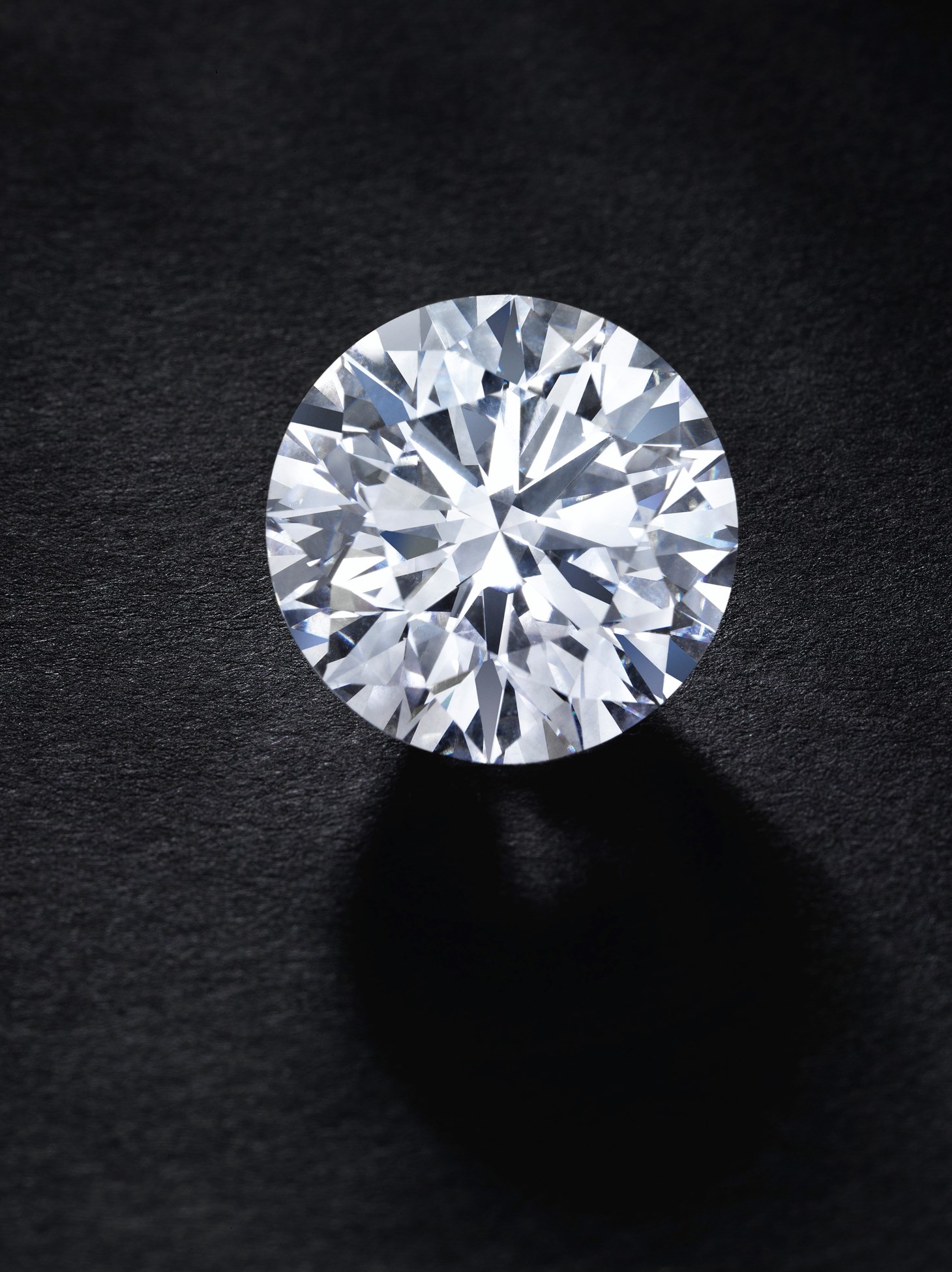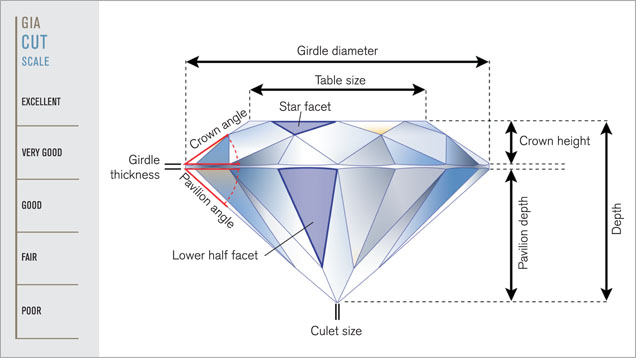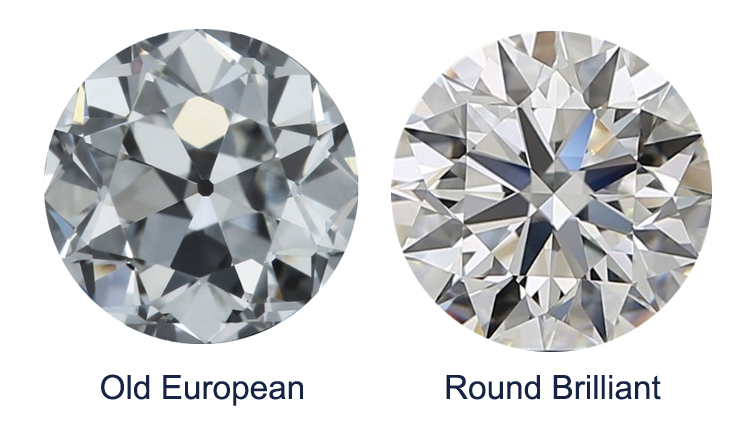Round Cut Diamond
Round Cut Diamond

Overview:
Round cut diamonds, as known as round brilliant cut diamonds, make up roughly 70-80% of all polished diamonds traded globally. Due to progress in research and the development of a standard methodology for grading diamonds, round diamonds are now treated as a commodity and their prices are increasingly becoming competitive with very small margins.
The Gemological Institute of America (GIA) introduced the standard cut grading system for “unmodified” round brilliant cut diamonds in 2005. According to GIA, in order for a round diamond to qualify as an unmodified round brilliant cut diamond, it must have 58 facets and be cut according to modern industry standards. The American Gems Society (AGS), on the other hand, uses a proportion-based grading system.
The diamond trade has evolved significantly over the last decade. Owing to the internet—and the abundance of information available online, first-time buyers are no longer at the mercy of local retailers for purchasing a high-quality diamond at a reasonable price. They can easily review diamond prices online on different websites and determine a competitive price in a given range.
For example, it is not hard to determine the price of a round cut 2-carat diamond with VS1 clarity, G color, excellent cut, and no fluorescence that is graded by either GIA or AGS. You can check directly at SGDX wholesale price and will get a good idea of what a good price is for the specified 2-carat diamond.
Finally, Lab grown diamonds are becoming more popular and could be good budget alternatives to mined diamonds.

Summary of Key Insights:
| Popularity | Round diamonds are the most popular among the diamond shapes. On account of its brilliance, it is often recognized as a symbol of the diamond trade itself. |
| Cut | A total depth of 59-62.5% and a total table of 53%-58.5% is preferred in round brilliant cut diamonds. Please see the chart below for detailed information and analysis. |
| Fluorescence | Although, oftentimes a negative factor, but it can be helpful in some cases. See more below. |
| Certification | GIA and AGS are the best grading labs. Buy a diamond that is graded by one of these two labs. |
| Color | While D to F are top color grades, we also recommend G color. Additionally, H and I are amazing budget color options to consider. |
| Clarity | Preferably, flawless to VSS/VS1 clarity ranges are great, but VS2 is also safe. SI1/SI2 are good budget options. When considering SI2 clarity diamonds, carefully review the clarity characteristics and location of inclusions to determine if the stone is eye clean. |
3 Red Flags to Avoid:
While we will thoroughly cover the 4Cs and additional important factors related to round diamonds below, here are the three red flags that should not be ignored in a round cut diamond.
- Do not compromise on the cut quality when it comes to round diamonds. Cutters have many tricks up their sleeves and will do anything to save more of the original rough diamond. Our proportions chart below will be your best guard against such tricks.
- Do not buy a round diamond the clarity grade of which is based on clouds. Such diamonds are dull and do not emit any brilliance. Read the comment section on a GIA report to find out if the clarity grade was assigned based on cloud (this is different from having clouds as inclusions, that is not a major issue).
- Avoid strong blue fluorescence, especially in D to G color round diamonds. Strong or very strong blue fluorescence in most cases affects high color grade diamonds very negatively.
Analyzing the Cut:
When it comes to the cut of round diamonds, while many marketers use taglines like “heart & arrows”, “hearts on fire”, “a cut above”, and so forth for their round cut diamonds, the benchmarks and methods for cutting a round brilliant cut diamond are more or less the same. Also, as long as a buyer abide by the guidelines listed below, s/he should be able to determine what a well-cut round diamond is and how it looks regardless of its brand name.
|
Depth % Poor/Fair: <56/>65% Good: 57.6-58/63.4-64.5 Very Good: 58-59/62.8-63.3 Excellent: 59-62.6 |
Table % Poor/Fair:<50/>68.5> Good:51-52/62-64 Very Good: 51-52/59-62 Excellent:53-58.5 |
|
Culet Poor/Fair: Medium Good: Small Very Good: None/Very Small Excellent: None |
Crown Angle Poor/Fair:<28.5/>38.5 Good: 30-32/36-38 Very Good: 32-34/35-36 Excellent: 34-35 |
|
Pavilion Angle Poor/Fair: <39/>46 Good: 41-42/44-45.3 Very Good: 41.3-42.6/43.3-43.8 Excellent: 40-41.2 |
Girdle Poor/Fair: Ex. Thin – Ex. Thick Good: Very thin – thick Very Good: Very thin – slightly thick Excellent: Thin – slightly thick |

For additional insights on diamond cut, check our article on is the diamond cut important. In this article, we explain that while the cut carries immense significance, if budget is an issue, you have the latitude of going as low as very good as long as the stone is not too deeply cut—in which case it would look very small—or is overly shallow—in which case it will look dull and have no fire and brilliance.

Excellent vs Super Ideal Proportions
The chart above can prove decisive in distinguishing a super ideal cut diamond from an ideal or excellent cut stone when comparing two diamonds graded as excellent cut by GIA. Pay attention to the crown and pavilion angles and the girdle size. Each one of these factors, besides the obvious quality of the depth and table, is responsible for the small difference in cut.
Analyzing the Color Issue:

Color is the second most important C after the cut in round cut diamonds. Color in white diamonds ranges from colorless (D-F), near colorless (G-J), and from then onwards to Z are considered faint, light, and faint yellow. While colorless diamonds are always preferred for people who can afford them, G/H color diamonds can still be amazing options. If you happen to buy an H or I color diamond, faint to medium blue fluorescence can be helpful as blue compliments yellow and can help make a diamond look whiter. Check our diamond color scale and chart for additional details.
Hint: If you find yourself at a standstill where you must choose between a VVS1 clarity H color or VS1 clarity G color diamond, go for the latter (VS1 G) — all other factors being equal.
Analyzing Diamond Clarity:
GIA grades diamond clarity from flawless to included 3 – FL to I3. Avoiding visible inclusions in a diamond is important for the overall appearance and brilliance of a diamond.
Clarity is one of the most technical Cs in a diamond. What type of inclusions are safe and what should be avoided?
In a nutshell, avoid big black crystals and make sure that the inclusions are not on the table of the diamond right in the center. Additionally, determine that inclusions are small and spread across the stone so that they are not visible to the naked eye. Finally, make sure that the clarity grade of the diamond is not based on clouds.
While clouds are not necessarily bad inclusions, if a stone’s clarity grade is solely based upon them, it means that it is full of them, hence hazy and oily and carrying no sparkle at all.

Prioritizing the 4Cs:
One of the hardest questions that shoppers often struggle to address is if and how to compromise on the 4Cs of a diamond — carat weight, cut, clarity, and color — in order to get the best diamond within a given budget range. To help answer this question, consider these four scenarios before making a final decision.
These four options include:
1 – Investment grade (highest quality and rare): buyers would prioritize flawless/VVS and colorless (D-E) diamonds with ideal proportions, GIA and AGS certification, and no fluorescence under this category.
2 – High-quality big diamonds (great value): in this range, a buyer would be looking for a VS2/VS1 and G/H color diamond with none, faint fluorescence, and excellent to very good cut grades. The goal here is to get the biggest bang for the buck without compromising on quality.
3 – Getting the biggest yet most beautiful diamond (a balanced approach): under this scenario, shoppers are on the lookout for the biggest stone possible without totally ignoring quality. Because they want a big diamond, they aim for a carat weight of 1.5 carats instead of a 1 carat. For example, they would buy a 1.5 carat round diamond with SI1 clarity, I-color, medium blue fluorescence, and very good cut instead of 1 carat E VVS1 clarity diamond.
4 – Getting the largest stone possible (a tight budget): a buyer mainly focuses on the size of the diamond and how much it shines and does not mind some visible inclusions or the yellow tint of a diamond with a lower price. As such, the buyer would buy a 2-3 carat K-M color diamond with inclusions being non-black carbon crystals such as feathers towards the girdle, strong blue fluorescence to aid the color, and very good to excellent cut for optimal brilliance and fire.
Additionally, here are our suggested options for buyers with budget constraints:
Excellent purchase:
- At least 1.0 carats in weight
- Very good or excellent cut with very good to excellent polish and symmetry
- G or above in color
- SI1 or above in clarity
- No/faint fluorescence
Very Good purchase:
- At least 0.90 carats in weight
- Very good cut with good to excellent polish and symmetry and very good proportions.
- H or above in color
- SI2 or above in clarity
- No, faint, or medium blue fluorescence
Good purchase:
- At least 0.80 carats in weight
- Good cut with good to very good polish and symmetry with good proportions.
- I or above in color
- SI2 or above in clarity
- None, faint or medium blue fluorescence
Round vs. Old European Cuts:
In today’s marketplace, roughly 75-80% of all the diamonds sold are round shaped. Since 1750, round diamonds have witnessed a plethora of changes especially in the variation of facet size and proportions. New changes are being made in a cut’s table size, total depth, culet size, crown height, and length of the lower half facets. Nonetheless, diamonds from every era have had distinctive and discrete appearances.
Most consumers tend to choose round brilliant-cut diamonds because they meet their modern conception of aesthetics. Round brilliant cut diamonds have a tight mosaic of light and carry dark patterns with longer lower half facets that gemologists term “splintery.”
The older cuts, the old European cut, on the other hand, has a small table, large culet, steep crown, and shorter lower half facets which gives them a “blocky” or “checkerboard” pattern. It is necessary to add here that despite their beauty, judging them against modern round brilliant cut diamonds is not practical due to differences in their proportions.
The Gemological Institute of America introduced the cut grading system for unmodified round brilliant cut diamonds. In order to distinguish between the older style brilliant-cut diamonds and the ones now in vogue, the term “unmodified round brilliant” is used for a symmetrical round cut diamond that has 58 facets and is cut according to the modern standards.
The GIA uses five cut grades including excellent, very good, good, fair, and poor to determine the cut of a round cut diamond. The AGS, on the other hand, uses six cut grades by adding “ideal cut” to the equilibrium.
Below are some of the key differences between old European and modern round brilliant cut diamonds:
According to GIA, old European cuts have the following specifications:
- Lower half facet length: less than or equal to 60 percent
- Table size: less than or equal to 53 percent
- Crown angle: greater than or equal to 40 percent
- Culet size: slightly large
Moreover, the 58-facet round brilliant cuts have to meet the following requirements to be called modern brilliant cuts:
- Lower half length: less than or equal to 60 percent
- Culet size: medium or a slight bit larger
- Star length: less than or equal to 60 percent.

The image above is a good side by side comparison of the two different round diamond cuts. Notice that the European cut has a smaller table, larger culet, and shorter lower-half facets as opposed to the round brilliant cut that has a larger table, smaller culet, and longer lower-half facets.

FAQs Related to Round Diamonds:
What is a round shape diamond?
As contended before, round diamonds are the most popular among all diamond shapes. Because round diamonds have a large surface size, they are generally more expensive than fancy-cut stones. A bigger, rough diamond is needed to cut a 1 carat round brilliant cut diamond instead of a 1 carat princess cut diamond. This is why round-shape diamonds are pricier than others.
What are the ideal proportions for a round cut diamond?
Please carefully review and follow our diamond proportion chart and guide for reference in order to determine optimal proportions for round diamonds.
What should I prioritize in terms of the 4Cs while buying a diamond?
The aforementioned four scenarios that we have explained should be very helpful in terms of prioritizing the 4Cs while considering a round diamond.
What are the most reliable diamond certifications?
As stated above, GIA and AGS are the best diamond grading labs in the world.
How does fluorescence affect a diamond?
In order to best understand the issue of fluorescence, carefully review our in-depth article on the issue. It is an important topic to fully understand as it can be either a negative (and in a few cases) positive factor depending on the color of the stone.
What is a good alternative shape to round diamonds?
In our opinion, an oval cut diamond would be a good alternative to round cut diamonds because of similarities.
Is it safe to buy diamonds online?
Yes, trading diamonds online is very safe now. Additionally, we now also have a standard grading system that makes buying a diamond online easier.
Credit: Sharif Khan on 17th Feb 2022
